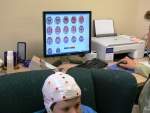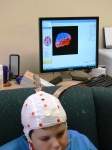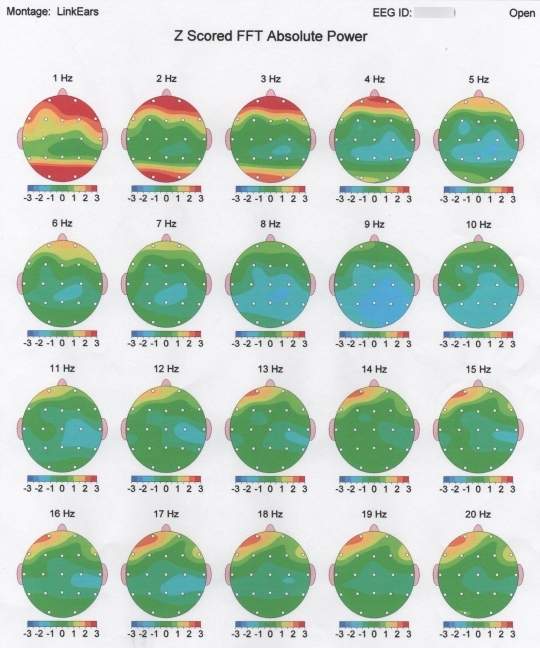QEEG
 Dr. Fisher provides quantitative electroencephalography (QEEG), also known as “brain mapping” or “neuroimaging.” QEEG is advanced brain imaging method that records brain electrical activity. Electroencephalography (EEG) is the recording and interpretation of brainwave activity. The term “quantitative” originates from the process of digitizing the EEG for the purpose of conducting mathematical calculations of brainwave activity that often includes comparison to a normative database (more on the database below.) QEEG can reveal areas of dysfunction within the brain’s electrical communication. Hypo- and hyper-electrical activity is two common areas of interest during the interpretation phase. For example, research has shown that persons with excessive anxiety and worry (called rumination) will often show areas of hyper-activity (often in the “beta” range), while those with depression will show areas of hypo-activity (decreased beta and increased alpha, particularly in the left hemisphere).
Dr. Fisher provides quantitative electroencephalography (QEEG), also known as “brain mapping” or “neuroimaging.” QEEG is advanced brain imaging method that records brain electrical activity. Electroencephalography (EEG) is the recording and interpretation of brainwave activity. The term “quantitative” originates from the process of digitizing the EEG for the purpose of conducting mathematical calculations of brainwave activity that often includes comparison to a normative database (more on the database below.) QEEG can reveal areas of dysfunction within the brain’s electrical communication. Hypo- and hyper-electrical activity is two common areas of interest during the interpretation phase. For example, research has shown that persons with excessive anxiety and worry (called rumination) will often show areas of hyper-activity (often in the “beta” range), while those with depression will show areas of hypo-activity (decreased beta and increased alpha, particularly in the left hemisphere).
Why Brainmaps?
There are many different types of neuroimaging, such as fMRI and SPECT. While other brain imaging methods have superior spacial resolution, EEG is known to have superior temporal resolution (i.e., can record electrical activity in terms of milliseconds). Thus, EEG is the preferred choice when electrical activity is the area of interest.
The human brain is essentially an electro-chemical organ. In the human brain, electricity triggers the release of neurotransmitters which then triggers more electrical activity. All human behavior that starts in the brain, which is most except certain reflexive actions in the body, have an electro-chemical origin. This includes thoughts, emotions, and motor movements. In theory, all psychological dysfunction should have an detectable electro-chemical correlate, but this is not the case due to limitations of the EEG (i.e., difficulty recording the deeper brain regions as well as imprecise discriminate abilities), at least with current technology. There have been nonetheless many discriminate EEG patterns identified for various psychologist disorders, such as attention deficit hyperactivity disorder (ADHD), traumatic brain injury (TBI), schizophrenia, depression, anxiety, and others. Moreover, general patterns of dysfunctional electrical activity are often revealed in the clinical EEG, and decades of QEEG and research guide clinical interpretation and predictions of observed dysfunction activity.
 A very important innovation is the development of normative databases. These are often referred to as “lifetime normative databases” because the developers record brain electrical activity of “normal” persons from a few months old to the 80’s or 90’s (“life span”). Normative databases help to provide an objective interpretation of the EEG. A patient’s recorded brainwave activity is mathematically compared to “normal” (i.e., free of known psychopathology or other medical ailments) persons who are the same age group. The normative database software also produce full color “brain maps” (see below for an example) that show areas of electrical dysfunction based on reliable mathematical estimates (i.e., often shown in standard deviations). As you can see, this is a somewhat complicated procedure, but Dr. Fisher provides a thorough explanation of the findings to each patient in terms that are hopefully meaningful.
A very important innovation is the development of normative databases. These are often referred to as “lifetime normative databases” because the developers record brain electrical activity of “normal” persons from a few months old to the 80’s or 90’s (“life span”). Normative databases help to provide an objective interpretation of the EEG. A patient’s recorded brainwave activity is mathematically compared to “normal” (i.e., free of known psychopathology or other medical ailments) persons who are the same age group. The normative database software also produce full color “brain maps” (see below for an example) that show areas of electrical dysfunction based on reliable mathematical estimates (i.e., often shown in standard deviations). As you can see, this is a somewhat complicated procedure, but Dr. Fisher provides a thorough explanation of the findings to each patient in terms that are hopefully meaningful.
How Are The QEEG Results Utilized?
QEEG findings are typically used to create neurofeedback protocols. To learn more about neurofeedback, please visit the neurofeedback section.
A very small percentage of patients may exhibit epileptiform or other medically deviant brainwave activity. In these cases, Dr. Fisher will also refer the patient to a neurologist for an additional medical examination.
What Can the Patient Expect During A QEEG?
 The QEEG is a painless process whereby a device that looks like shower cap with many wires is placed on your head. A considerable amount of EEG gel will be used, but this gel is water soluble and thus easily washes out. You will be asked to sit quietly with as little movement as possible with your eyes opened and focused and at other times with your eyes closed. The entire process takes about 30 minutes to 1 hour to complete. Prior to your visit, you will be given specific instructions on how to prepare for your QEEG, but some the basic ones include a thorough washing of your hair, a good night’s rest, breakfast, and free of substance(s) to the safest extinct possible (alcohol, drugs, medications, etc.). Regarding, the latter requirement, a patient should never stop taking a prescription medication without first discussing this with their physician, particularly for medications known to create physiological dependence, such as anti-depressant, anti-psychotic, and anti-anxiety medications.
The QEEG is a painless process whereby a device that looks like shower cap with many wires is placed on your head. A considerable amount of EEG gel will be used, but this gel is water soluble and thus easily washes out. You will be asked to sit quietly with as little movement as possible with your eyes opened and focused and at other times with your eyes closed. The entire process takes about 30 minutes to 1 hour to complete. Prior to your visit, you will be given specific instructions on how to prepare for your QEEG, but some the basic ones include a thorough washing of your hair, a good night’s rest, breakfast, and free of substance(s) to the safest extinct possible (alcohol, drugs, medications, etc.). Regarding, the latter requirement, a patient should never stop taking a prescription medication without first discussing this with their physician, particularly for medications known to create physiological dependence, such as anti-depressant, anti-psychotic, and anti-anxiety medications.
Please feel free to contact Dr. Fisher with any additional questions you might have. Dr. Fisher offers free neurofeedback initial consultations (i.e., to determine if neurofeedback and QEEG might be an appropriate and beneficial treatment for you).
Example QEEG Brainmap:

This example is an eyes-opened brain map that shows distributed brainwave activity in absolute power Z-scores with 1Hz bins (1-30Hz)

